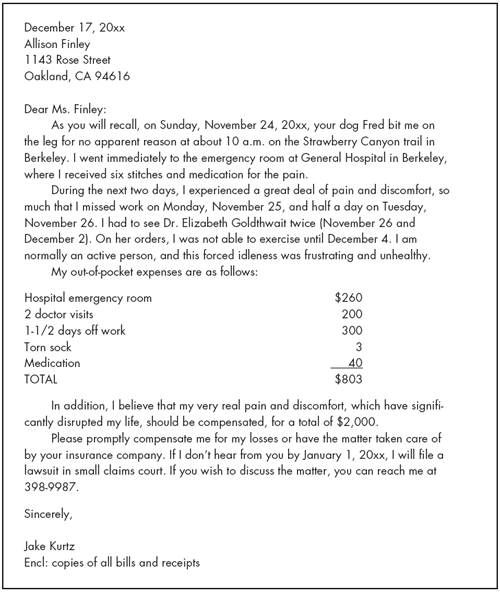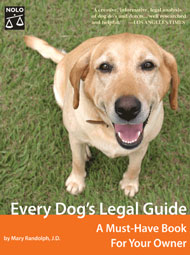A Small Claims Court Case
The best way to show how small claims court works is to follow a hypothetical case from beginning to end. Here is how a typical case might unfold:
One Sunday morning, Jake was jogging along a dirt trail when he met two women and a dog. The dog, Jake thought, looked like a cross between a large Doberman and a medium-sized wolf. Because the women and the dog took up most of the center of the road, Jake moved to the far right edge. Then, noticing that the beast was on a long leash, he moved off the path into the ditch.
As it turned out, Jake didn't go quite far enough. The dog lunged for him, fangs first. Jake tried to bound into the brush at the side of the ditch (poison oak looking like the lesser of two evils at the moment), but he wasn't quick enough. The dog bit Jake's ankle before the woman holding the leash could restrain him.
Jake yelled in pain, the woman hauled the dog back to the other side of the road and her friend went to see how bad the bite was. Before Jake hobbled off to see a doctor - his ankle was bleeding from a good-sized gash - he got the name and phone number of the dog's owner, Allison Finley, and of her friend, Kathleen Huxley.
Because it was Sunday morning, Jake had to go to a hospital emergency room to see a doctor. After he sat an hour in a crowded waiting room, a doctor stitched up the bite and gave him some painkillers and orders to stay off the leg for a few days. Jake spent the rest of the day restless and uncomfortable. He didn't sleep well that night, and decided not to try to go to
work on Monday. Tuesday morning, he saw his regular doctor, who pronounced the wound "healing nicely." That afternoon he limped back to work.
Meanwhile, Jake contacted officials at the county animal control department, notifying them of the incident and confirming that the dog was properly licensed and vaccinated for rabies. Jake consoled himself with the thought that at least he wouldn't start foaming at the mouth. After a few weeks, he could jog again without pain, although his fear of encountering the beast again prompted him to choose a new route. Jake decided it was time to add up his costs and demand payment from Allison Finley.
Looking Up the Law
First, however, he decided to check on California law to see just what he was entitled to. Looking up "Dogs" in the general index of the California code (the state statutes) gave him a long list of laws. The most promising was under "Bite, liability of owner." Jake turned to the statute.
It read, in part: "The owner of any dog is liable for the damages suffered by any person who is bitten by the dog while in a public place … regardless of the former viciousness of the dog or the owner's knowledge of such viciousness."
Reading the statute closely told Jake he had to prove:
- Allison Finley owned the dog
- the dog bit him
- he was in a public place when bitten, and
- he suffered damages as a result.
Piece of cake, Jake thought. Allison couldn't even argue about anything but the amount of the damages. And as far as Jake could tell, she didn't have any defenses to make - nobody could say, Jake was sure, that by jogging along minding his own business he had provoked the dog into biting him.
Adding Up Damages
Jake's out-of-pocket costs looked like this:
| Hospital emergency room | $260 |
| 2 doctor visits | 200 |
| 1-1/2 days off work | 300 |
| Torn sock | 3 |
| Medication | 40 |
| TOTAL | $803 |
CHOOSING A STRATEGY
If your state doesn't have a dog-bite statute, or if it doesn't apply in your situation, you may be able to sue under the common law rule or a negligence theory, discussed above.
To win under a common law theory, you must prove that the owner knew (or should have known) that the dog was likely to cause the kind of injury suffered.
The third option, trying to prove a dog owner was negligent, is usually desirable only if there's no dog-bite statute to sue under, and it doesn't look possible to prove, on a common law theory, that the dog's owner knew the dog was dangerous.
In some states, time limits on filing lawsuits may differ depending on the theory of the lawsuit. For example, in Arizona, lawsuits under the dog-bite statute must be filed within one year of the incident. But an injured person who sues under a common law theory has two years to file a case.73
But what about his pain and suffering? Jake had spent two very uncomfortable days, and another ten unable to do a lot of the things he enjoyed, such as running and playing tennis. His pleasure in jogging on his formerly
favorite running trail had also been displaced, in part, by anxiety about being attacked again. Puzzling over a monetary amount for this, Jake decided he didn't want to ask for a ridiculously large amount and feel as irresponsible as the dog's owner, but he did feel wronged. Finally he decided to ask for a total of $2,000.
Negotiating
Jake's next step was to call Allison Finley, who told him she considered the whole incident at least half his fault. Her theory was that when Jake leaped into the ditch, it sent a signal to Fred, her dog, that Jake was afraid and fleeing. It's a well-known fact, she went on, that dogs naturally go for cowards. Eventually, she offered to pay Jake's medical bills but nothing else, claiming Jake could have gone to work if he had wanted to.
Jake, his blood pressure rising, hung up and went for a walk. When he'd calmed down, he wrote a letter. In California, such a demand letter is required before a small claims suit may be brought. In any state, it's a good idea.
A few days later, Jake got a reply from Allison. She said she didn't have any insurance and offered to pay $600 in six monthly installments. He filed his small claims court suit the next day.

Settlement
Let's interrupt this story (dramatic as it may be) and give it an alternate ending: Allison suffered a change of heart and called Jake back, offering to pay $1,400 if he wouldn't take her to court. Jake, rather than go through the hassle of small claims court, where he is not guaranteed to get anything, accepted her offer. Jake and Allison get together to put their agreement in writing, using a personal injury release form such as the one shown below, taken from 101 Law Forms for Personal Use, by Robin Leonard and Ralph Warner (Nolo).74
To prepare for his court appearance, Jake first gathered all his emergency room, doctor, and pharmacy bills and made photocopies of them. He also got a statement from his boss, documenting the time lost from work.
He then called the only witness to the incident, Allison's jogging companion, Kathleen Huxley. She obviously felt bad about what had happened, but didn't want to testify against her friend. Finally, she agreed to write a four-sentence note confirming that Jake had not provoked the dog and had tried to avoid it, and that the dog had lunged at and bitten him. (This kind of letter is generally allowed in small claims court, but not in regular court.) Jake could have had Kathleen served with a subpoena - an order to show up and testify in court - but he decided against it, for the sensible reason that it wouldn't be wise to force an unwilling witness to come to court.
Thinking about what other evidence would be convincing to a small claims court judge, Jake decided a picture of ferocious-looking Fred the dog would definitely help. To get it, Jake sent a neighborhood teenager who was an avid amateur photographer to Allison's house, where Fred was in a fenced yard and easily visible from the street.
Preparing for Court
The only witness Jake decided to call at his hearing was a friend who had brought him homemade chicken soup when he was laid up the day after the incident. She would testify to Jake's obvious suffering.
In court, everything went just about as Jake had expected. He presented all his evidence and even did a Lyndon Johnson routine, showing the judge the scar on his ankle. Allison testified that Fred was really a sweet animal. She reminded the judge that several women had been attacked while jogging in the area, and said she needed the dog for protection. She brought along a couple of witnesses who said nice, but irrelevant, things about Fred's good disposition. (Whatever impression that testimony made, Jake thought to himself, was dispelled by the snapshot of Fred.)
What did the judge say? We gave this hypothetical to four experts: two small claims court judges and two small claims court advisors (court employees who help people going to small claims court prepare their cases). Their verdicts:
| Their verdicts: | |
|---|---|
| Judge #1: | $2,000 |
| Judge #2: | $1,300 |
| Advisor #1: | $900 |
| Advisor #2: | $860 |
There's no better way to show you the inherent unpredictability of taking a dispute to court, even when a jury isn't involved.


